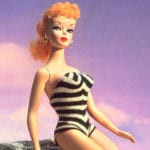 Mysteries
Mysteries  Mysteries
Mysteries  History
History 10 Surprising Stories About the Texas Rangers
 Humans
Humans 10 Philosophers Who Were Driven Mad by Their Own Theories
 Miscellaneous
Miscellaneous 10 Video-Game-Worthy Weapons and Armors from History
 Weird Stuff
Weird Stuff 10 Psychics Who Accurately Predicted Wartime Events
 The Arts
The Arts 10 Pieces of Art Inspired by a Broken Heart
 Health
Health 10 Science Fiction-Sounding New Medical Treatments
 History
History 10 Surprising Facts About the Father of Submarine Warfare
 Space
Space Ten Astonishing New Insights into Alien Worlds
 Weird Stuff
Weird Stuff 10 Bizarre Summer Solstice Rituals Still Practiced Today
 Mysteries
Mysteries Top 10 Haunting Facts About the Ghost Ship MV Alta
 History
History 10 Surprising Stories About the Texas Rangers
 Humans
Humans 10 Philosophers Who Were Driven Mad by Their Own Theories
Who's Behind Listverse?

Jamie Frater
Head Editor
Jamie founded Listverse due to an insatiable desire to share fascinating, obscure, and bizarre facts. He has been a guest speaker on numerous national radio and television stations and is a five time published author.
More About Us Miscellaneous
Miscellaneous 10 Video-Game-Worthy Weapons and Armors from History
 Weird Stuff
Weird Stuff 10 Psychics Who Accurately Predicted Wartime Events
 The Arts
The Arts 10 Pieces of Art Inspired by a Broken Heart
 Health
Health 10 Science Fiction-Sounding New Medical Treatments
 History
History 10 Surprising Facts About the Father of Submarine Warfare
 Space
Space Ten Astonishing New Insights into Alien Worlds
 Weird Stuff
Weird Stuff 10 Bizarre Summer Solstice Rituals Still Practiced Today
Top 10 Soundtracks Created On The Amiga
Back in the early days of the computer game industry, the music, as well as everything else, had to be painstakingly programmed in by hand. Getting the music to sound anything like a real tune was hard enough, but getting the instruments to sound anywhere near authentic was almost impossible. Thankfully, as the 80’s turned into the 90’s, machines got bigger and better, and with a lot more resources to not only incorporate music, but to make a half decent job of reproducing the instruments as well.
At the time, the market leader in game music quality was the Commodore 64; which had three whole audio channels to play around with; while rivals Spectrum, Atari, Amstrad and PC had to make do with single channel ‘plinky-plonky’ music and sound effects. Then along came the Commodore Amiga (and thanks to stolen blueprints, the Atari ST), with new 16-bit technology, and up to 8 available audio channels to mix down to high quality stereo. In addition, the Amiga (and ST) were fully MIDI compatible; which essentially meant that a computer and a synthesizer would be linked directly to each other at last. It wasn’t long before the seasoned hacks of game audio realised the possibilities of this new solution, and began to experiment.
These are some of the most memorable theme tunes to come out of that five year period, before the CD brought studio sound to the world of gaming. Note: Due to the limitations of the Youtube media available, some of these soundtracks are cut short, are of poor quality, or do not represent the game graphics to their fullest or most fluid. This is the first of two lists which will eventually comprise the 20 best.
SWIV (short for Silk Worm IV) is a vertically scrolling shoot-em-up where the player takes control of either a helicopter or a battle jeep to negotiate a vast landscape and hundreds of attacking enemies. In keeping with the somewhat futuristic and military aspects of the game, Andrew Barnabas carved out a brash and upbeat main theme using music which would not be out of place in an action movie of that period. Andrew is very prolific, and is still at the forefront of game music today with the likes of Fable II, Star Wars: The Force Unleashed, and Tomb Raider: Underworld.
Pinball Fantasies is the second of three pinball simulators created by Digital Illusions on the Amiga, creating the very first vertical scrolling virtual pinball tables with an authentic feel. Each game came with four tables of varying difficulty and appeal, with usually one of these standing out as a real jaw-dropper. These games also earned a reputation for their long introductions and scores, both of high quality and atmosphere. This second game score by Gustafsson is a vastly more polished track than it’s predecessor (Pinball Dreams) and stands out as a synth-heavy and quite edgy futuristic anthem. In 2005, he left Digital Illusions to start a new company, called Motherlode Studios, later known as Epos Game Studios AB.
Zool (Ninja ‘ant’ of the “Nth” Dimension) is a scrolling platformer similar to the Super Mario games, where the player has to run along and jump over a landscape of cute but deadly creatures and scenery. Deceased foes release extra Health, and the player could stick to walls in his attempt to negotiate the surprisingly tricky levels. One of the stand-out aspects of the game was the theme, which could be selected as one of two in-game tunes. Combining cutesy techno samples with hardcore break-beats, the music capitalised on the urgency needed to play the game through. Recently, Phelan founded Full Circle Audio to provide audio solutions for games. He now writes music for commercials, sound design for TV and also provides consultancy and game design services.
Turrican 2 is a multi-directional scrolling platform shoot-em-up, with the player in command of a heavily armoured robo suited character with a variety of lethal weapons. Among these, the character wielded a very powerful ‘Ghostbusters’ type particle laser, smart bombs, bouncing bullets, and could disappear into a gyroscope to slip down cracks and to dice enemies to bits. The main theme was another master-piece, combining some aspects of opera and synth-pop to emphasise the main Turrican theme developed in the first game. By playing through the whole theme, the player was rewarded with a cartoon slideshow depicting the games’ story-line. Available on the album “Turrican Soundtrack”, remixed by the author.
Apidya is a very unique game indeed. It features the main character as a wasp (a wasp?), weaving it’s way across a meadow, a pond and a sewer, and avoiding or destroying all the insect life it encounters along the way. The games soundtrack follows running themes and ‘hooks’ and develops as each stage of the game is completed – a real encouragement to the player to battle through the mayhem on screen. Chris Hülsbeck has orchestrated many of his classic themes, and his music from Apidya, Turrican 2, Turrican 3 and Great Giana Sisters was performed live at the Symphonic Game Music Concert series in Leipzig, Germany between 2003-2007. The concert album “Symphonic Shades” was released on December 17, 2008. The Apidya theme is also available on the album “Apidya Soundtrack”, remixed by the author.
SWOS is a top-down scrolling soccer game – in the same miniature scale as Cannon Fodder, and features our final theme by composer Richard Joseph. By now, the technology existed to compress audio samples to such a degree that full speech songs were now possible, and “Goal-scoring Superstar Hero”, sung by Jackie Read, did just that. The song was a triumph of the latest resampling techniques and featured a chorus as well as a verse. A later remix of this song, made for “Sensible Soccer 2006”, had another two verses added to it. The CD version of the game also included the studio recording as an audio track. Richard Joseph went on to win the BAFTA Award in 2000 for best audio in the game “Theme Park World”. He died of lung cancer in early 2007.
State of the Art is another demonstration of the sound and graphical capabilities of the Amiga, using advanced programming techniques to combine silhouette dancers with hardware generated special effects – one of the very first sources to do so to such an
extent. The music is in the hardcore rave style that was very popular at that time, using many high quality synth sounds and modern sounding rhythms; which seems to complement the presentation to a tee.
Project X follows the classic side-scrolling shoot-em-up formula of R-Type and features a selection of ships as well as a wide range of upgradeable weapons and gadgets to help the test pilot through the levels. It also had a very up-to-date soundtrack for the period. The main theme returned once again to the hardcore rave scene and in doing so created one of the most recognisable themes on the Amiga. There are several versions of the theme, and the author himself has remixed and reconstructed it for mainstream release. Allister now works as a freelance musician and sound designer for the games and console industry with Anthony Putson as “Orchestral Media Developments”.
9 Fingers was one of the later graphical demos to be released by Spaceballs on the Amiga. If features an updated version of the silhouette model created for the State of the Art demo the year before, and falls back on hardcore trance music to showcase the effect. This time, the technology allowed for more fleshed out human features and also a slightly higher quality audio experience. The theme is short and not very technical in it’s use of the format, but manages to sound almost studio quality in its production – a real step forward in computer sound until the CD age brought ‘real’ audio to the industry. This demo is also incredible in that it manages to squeeze all that onto one 880k disc! Today, storing just one single picture or a frame of animation may require more than 1MB! Rune Svendsen is currently involved in stage and theatre production.
Xenon 2 – Megablast – is a vertical scrolling shoot-em-up with all the associated toys and weapons of that genre. To give the game the edge, the games creators – The Bitmap Brothers – co-operated with the British musician Tim Simenon of ‘Bomb The Bass’ to include the hip-hop track ‘Megablast – Hip Hop On Precinct 13’ (which is also the origin of the game’s subtitle), as the title music – to become the very FIRST game to accurately include an existing pop single as its theme. The song itself is based on the theme of John Carpenter’s ‘Assault on Precinct 13’ movie, and also features samples from Sly and the Family Stone song, ‘You Can Make It If You Try’. There are two versions of the track in the game: a nearly faithful rendition (only missing a few spoken lines) as the loading music, and a simplified version as the in-game background music. The Amiga version also had a few changes; such as helicopter sound effects at the beginning and ending of the track. David Whittaker is also no stranger to programming audio hits. His sub-tune of ‘Lazy Jones’ was the basis for the dance hit ‘Kernkraft 400’ by Zombie Nation, which went to number 1 in many European countries. David is still busy today working on the LEGO (Star Wars, Indiana Jones, Batman) action series of games.








